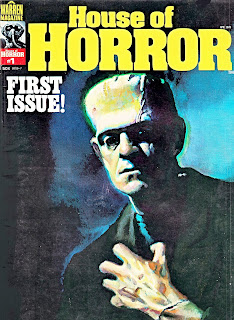Video Nasty (2014)
Uncredited cover art for Warren's House of Horror #1 (April 1978), an "ashcan" produced to quash Top Seller's intention of House of Hammer reaching US shores.
AT the beginning of 1978, the US publishing empire of Jim Warren - responsible for Famous Monsters of Filmland and the b&w comic magazines Creepy and Eerie - announced a new quarterly venture House of Horror to be made available through their in-house mail order service Captain Company. Yet the truth was that the publisher rushed this magazine - which was always intended as a one-shot - into print for copyright reasons, securing the name and halting Top Seller's plan to release their respected House of Hammer in America under the same title. Warren was infamous for his volatile working practices, but any publisher who had the audacity to challenge his domain particularly created embitterment. Both mags were reprints: hardly a House of Horror at all, Warren's effort revisited paste-ups from Famous Monsters such as the special effects of CLOSE ENCOUNTERS and the robots of STAR WARS; Top Seller's collation included John Bolton's CURSE OF THE WEREWOLF comic adaptation, a George A. Romero interview, and Brian Lewis' VAMPIRE CIRCUS cover which originally graced House of Hammer #17.
When Warren immediately filed for copyright infringement against the British invaders, the US courts upheld his claim, so Top Seller's American adventure lasted two issues: (Hammer's) House of Horror #1 and the next issue of the regular title, #19, which received limited distribution. Because of this, Top Sellers were forced to change the name of their homegrown version to (Hammer's) Halls of Horror with #20. This was a stunt the American publisher also pulled over the fabled birth of Eerie in 1965. Warren printed around 400 copies of House of Horror, but only 200 editions of Eerie #1 existed. Warren discovered that another publisher who used the same distributor was bringing out an imitation of Creepy called Eerie, thereby inventory material from Creepy was used to cobble together his version of the title, which was on the newsstands outside his distributor's building the following morning. The most ridiculous aspect was that Warren had his facts wrong: the company who challenged him was Eerie Publications, and the magazine in question was called Weird.
 Each with a cover by Graham Humphreys, Video Nasty is a breezy Reaper comic that deals with weighty agendas.
Each with a cover by Graham Humphreys, Video Nasty is a breezy Reaper comic that deals with weighty agendas. Top Sellers supremo Dez Skinn remains tactful towards Warren, championing his business sense. Warren initially heard the news of the British assault in Comic Media News, where Skinn proudly announced 200,000 copies of his House of Horror were set to conquer America. By the most unlikely of coincidences, that same issue featured an interview with Warren, so the editor sent him a complimentary copy. The first Top Sellers knew of the situation was when their office received a letter from Warren’s lawyers, stating that shipping copies for US distribution would be infringing the copyright of their client’s “well established” House of Horror magazine on which a “considerable amount” had been spent. The hard fact is that, against this messy backdrop, American readers were deprived of a quality publication, instead left with the pictorial and pun-filled standard of Famous Monsters.
Former comic store owner turned independent writer, Mario Covone's six-issue Video Nasty is set in 1983 Kettering, and uses both the video panic in Britain, and the political climate of the era, as its provocative foundation. Along with Greek artist Vasilis Logios, Covone has produced a love letter to the genre, inspired by the documentary VIDEO NASTIES: MORAL PANIC, CENSORSHIP AND VIDEOTAPE and Lucio Fulci's THE BLACK CAT. Characters are archetypes without being bland, as the police, neo-Nazis and a film director turned media scapegoat are sucked into a pit of depraved murders. Mario's crisp dialogue creates a flowing yarn which exists in a fictionalised but recognisable tableau - the relocation from Manchester to Northampton of "God's Cop" Chief Constable James Anderton for example, as he instructs officer David Gorley to look at video nasties for case research (by the end of the second issue, Gorley has acquired ZOMBIE FLESH EATERS and CANNIBAL HOLOCAUST from his friendly video store). What inevitably hurts the book is the frighteningly sketchy interior art of Logios; proportions vary wildly from panel to panel, and what is even more surprising are the standard of Graham Humphreys' covers; while #5 and #6 have a grandiose power, the first four covers lack focus.



